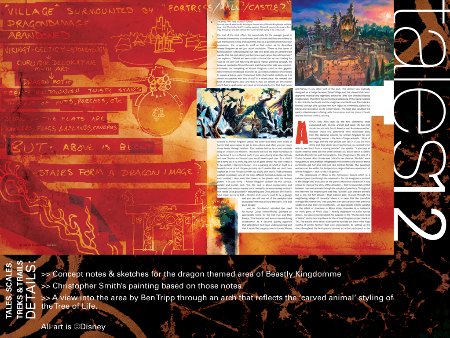Disney's Animal Kingdom at Ten
Page 5 of 5

Click here for a much larger version of this picture
The centerpiece of Africa is the Kilimanjaro Safaris which is a turbulent jeep ride through the savannahs. For the imagineers involved in the design and execution of the park�s interactive adventure it was critical to impress the story of the attraction � that fundamental conflict between man and animals through the subplot of poachers. Throughout the interview Joe emphasized that they �couldn�t just present animals like a zoo but tell stories.� That subtext also courses through the neighboring village of Harambe where it is clear that the townsfolk manage the reserve and that poachers can destroy both their precious wildlife but also their own livelihoods � an appropriate real-life parallel for the effect of poachers in Africa today. Harambe is a metaphor for many parts of Africa today � heavily depend on safari tourist dollars. By setting up the story throughout the land guests become an active participant in the subplot of thwarting the ivory hunters.
Clever master planning is the cornerstone of Animal Kingdom. The entire site is around 1,000 acres and less than half had been developed for the opening day menu. Joe and his team knew they had a huge contiguous canvas to play with for the future. The first development that opened less than a year after the rest of the park was Asia. The original plan called for a water safari on a similar scale to Kilimanjaro Safaris. However as the design team began to make forays into countries as diverse as India, Bali and Nepal a new storyline emerged for the aquatic adventure. The imagineers observed that there was a direct conflict between explosive population growth and the traditional (and often religious) respect for the environment and all living creatures. The show writers and producers working on Tiger Rapids Run (the development name as the big cats were to be the main attraction of the raft ride) decided that the visualization of habitat destruction would be too traumatic for the wildlife and thus eliminated the animal portion. Instead the imagineers heightened the thrill factor by turning the adventure into a turbulent whitewater experience as guests encounter the consequences of illegal logging. Asia was expanded in April 2006 when the park�s first mountain opened. �We had a mountain on the master plan from about �90 although we didn�t know what it was going to be except that it needed to be Himalayan,� Joe explains. �The addition benefit of Everest is that intuitive navigation around the park has improved. The Tree of Life doesn�t do that job very well as it is so uniform but Everest has a front, back and side and people can find it better than the park�s icon.� The development of Expedition: Everest was covered in detail in Issue 3 of Tales from the Laughing Place (and is available as a back issue).

Click here for a much larger version of this picture
Nearly two decades on from that initial pitch to Marty for a project of his own Joe Rohde remains uncompromisingly committed to the fourth theme park at Walt Disney World. Few imagineers have left such an indelible mark on a single park for so long. So the inevitable question arises - what is next for Animal Kingdom? Aquatic environments? Mythical creatures? �We felt that we had the right mix in the first web of products for the park,� Joe asserts. �We deliberately avoided marine life as it was already served elsewhere unless it was appropriate to the stories we were telling. Beastly Kingdomme is more of a mantra rather than a specific concept. It represents our commitment to begin to embrace more than just biological animals. The Yeti [within Expedition: Everest] is just the beginning of the trend to begin to widen the theme.�
Discuss It
Related Links
-- Posted December 5, 2008
-- Text by Lee MacDonald
-- Layouts by Lindsay Cave

